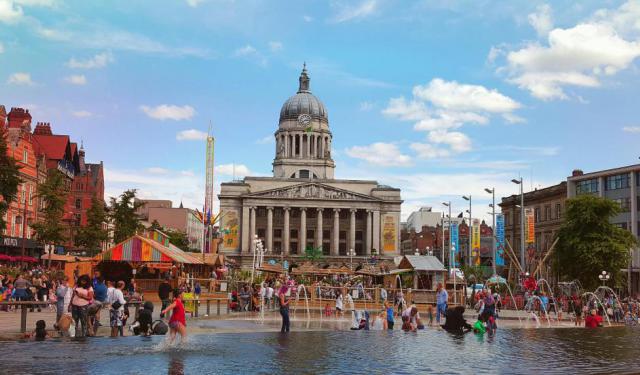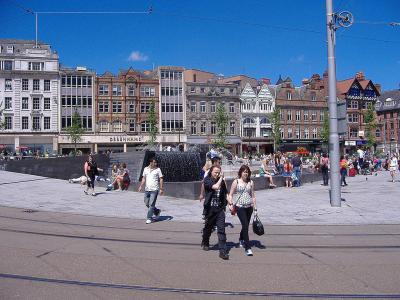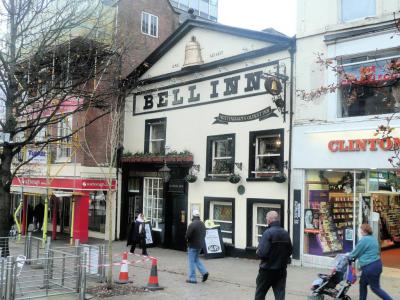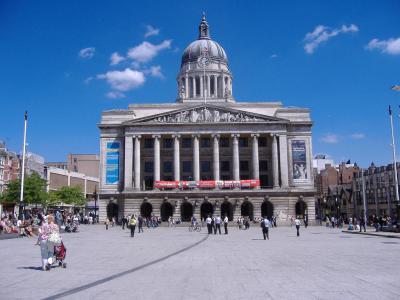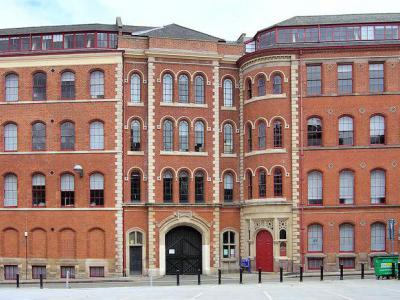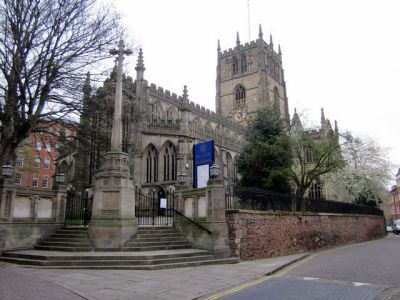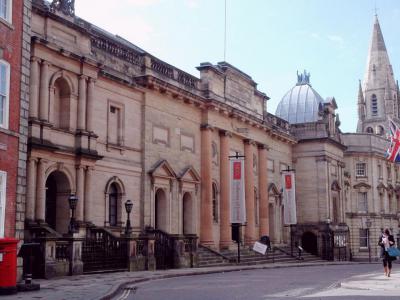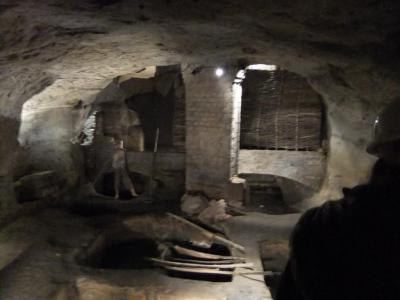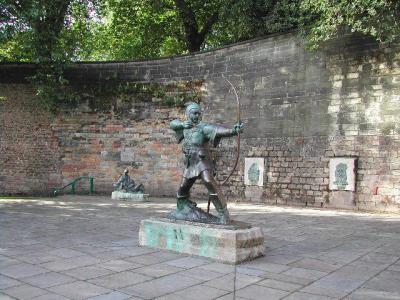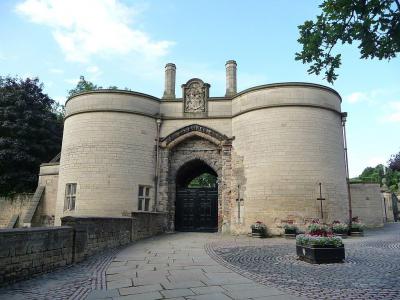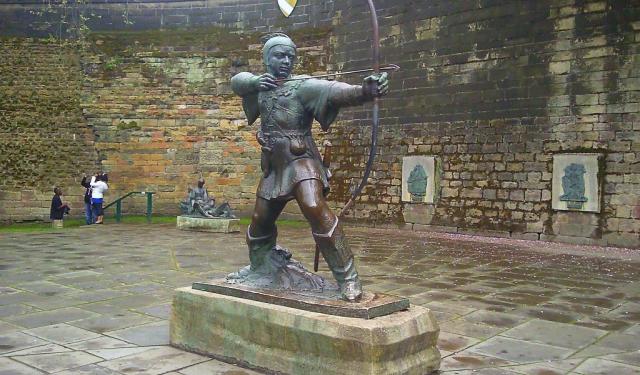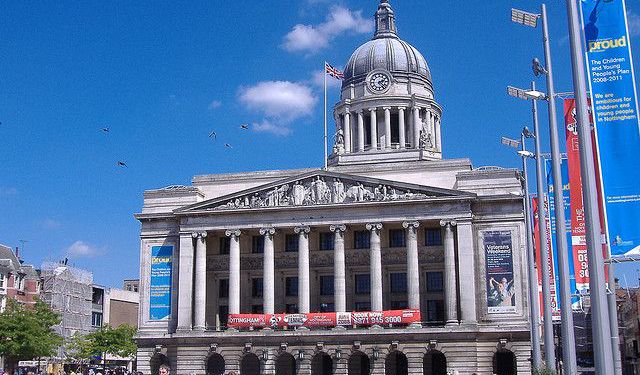Nottingham Introduction Walking Tour (Self Guided), Nottingham
Nottingham was known only as "The Place of Caves" in 600 AD. A Saxon chief named Snot ruled "Snotingaham", or, "the home of Snot's people." It was part of Danelaw in the 7th century, administered from a stone Hall on High Pavement, the first street of Nottingham.
In 1068 Norman invaders built a wooden motte-and-bailey fortress on a high sandstone promontory. William Peverel was granted a charter by William the Conqueror that included manors and lands around the fortress. Peverel established a French section next to a Saxon settlement. The empty land between became the Market Square of Nottingham.
Nottingham shall forever be connected to the names of Richard the Lionheart, King John, the Sheriff of Nottingham, and above all, Robin Hood. When Richard returned from the Crusades in 1194, he besieged King John and the Sheriff in Nottingham Castle. In legend, the castle is also the scene of the final struggle of the Sheriff and Robin Hood.
Nottingham Castle was changed to a stone fortress by Henry II. In 1651 it was destroyed in the Civil War. In 1660 it was rebuilt as the ducal Manor of Lord Cavendish. It is presently an art gallery and museum.
Medieval sights are preserved in the compact Old City area: Three churches, St Mary's, St Peter's and St Nicholas predate the Tudor era. Three pubs are even older: The Bell Inn, Ye Olde Trip to Jerusalem, and Ye Olde Salutation may be the oldest operating pubs in Britain. The whole place is honey-combed with ancient caves and tunnels.
Nottingham's Market Square is the nexus of the city. Here is the neo-Baroque Council House with its 200 foot dome. The Lace Market area holds St Mary's Church, the Victorian Adams Building, the National Justice Museum and Historic High Pavement.
Medieval and modern are alive within walking distance of the Market Square: Dining, shopping, museums, the arboretum, the churches, cinema and theatre. Take a walk in merry, busy, Nottingham.
In 1068 Norman invaders built a wooden motte-and-bailey fortress on a high sandstone promontory. William Peverel was granted a charter by William the Conqueror that included manors and lands around the fortress. Peverel established a French section next to a Saxon settlement. The empty land between became the Market Square of Nottingham.
Nottingham shall forever be connected to the names of Richard the Lionheart, King John, the Sheriff of Nottingham, and above all, Robin Hood. When Richard returned from the Crusades in 1194, he besieged King John and the Sheriff in Nottingham Castle. In legend, the castle is also the scene of the final struggle of the Sheriff and Robin Hood.
Nottingham Castle was changed to a stone fortress by Henry II. In 1651 it was destroyed in the Civil War. In 1660 it was rebuilt as the ducal Manor of Lord Cavendish. It is presently an art gallery and museum.
Medieval sights are preserved in the compact Old City area: Three churches, St Mary's, St Peter's and St Nicholas predate the Tudor era. Three pubs are even older: The Bell Inn, Ye Olde Trip to Jerusalem, and Ye Olde Salutation may be the oldest operating pubs in Britain. The whole place is honey-combed with ancient caves and tunnels.
Nottingham's Market Square is the nexus of the city. Here is the neo-Baroque Council House with its 200 foot dome. The Lace Market area holds St Mary's Church, the Victorian Adams Building, the National Justice Museum and Historic High Pavement.
Medieval and modern are alive within walking distance of the Market Square: Dining, shopping, museums, the arboretum, the churches, cinema and theatre. Take a walk in merry, busy, Nottingham.
How it works: Download the app "GPSmyCity: Walks in 1K+ Cities" from Apple App Store or Google Play Store to your mobile phone or tablet. The app turns your mobile device into a personal tour guide and its built-in GPS navigation functions guide you from one tour stop to next. The app works offline, so no data plan is needed when traveling abroad.
Nottingham Introduction Walking Tour Map
Guide Name: Nottingham Introduction Walking Tour
Guide Location: England » Nottingham (See other walking tours in Nottingham)
Guide Type: Self-guided Walking Tour (Sightseeing)
# of Attractions: 9
Tour Duration: 2 Hour(s)
Travel Distance: 2.5 Km or 1.6 Miles
Author: StaceyP
Sight(s) Featured in This Guide:
Guide Location: England » Nottingham (See other walking tours in Nottingham)
Guide Type: Self-guided Walking Tour (Sightseeing)
# of Attractions: 9
Tour Duration: 2 Hour(s)
Travel Distance: 2.5 Km or 1.6 Miles
Author: StaceyP
Sight(s) Featured in This Guide:
- Old Market Square
- Bell Inn
- Nottingham Council House
- Adams Building and Lace Market
- St. Mary's Church
- National Justice Museum
- City of Caves
- Robin Hood Statue
- Nottingham Castle
1) Old Market Square (must see)
The Domesday Book of William the Conqueror records the 1068 grant to William Peverel. The grant, called "Honour of Peverel", was for 162 manors, and present-day Nottingham. Nottingham then consisted of two towns. One was Saxon, based at Saint Mary's Church, and one was French, by Castle Rock. The people of the two towns did not overly love each other.
The Market Square, a great vacant area of about five acres, was the center point of the two towns. The perimeter of the square was formed by Long Row West and East, High Street, Poultry, South Parade, Beastmarket Hill and Angel Row. A wall divided the square in two. It came down in 1727. The square today covers about three acres.
The Council House dominates the Eastern end of the square. It has a wide portico with columns and a pointed roof surmounted by a classical Florentine dome. The central open space is paved with granite. There are fountains, terraces and flowerbeds. The new square is designed for events, parades, concerts and a regular farmers' market.
The Market Square, a great vacant area of about five acres, was the center point of the two towns. The perimeter of the square was formed by Long Row West and East, High Street, Poultry, South Parade, Beastmarket Hill and Angel Row. A wall divided the square in two. It came down in 1727. The square today covers about three acres.
The Council House dominates the Eastern end of the square. It has a wide portico with columns and a pointed roof surmounted by a classical Florentine dome. The central open space is paved with granite. There are fountains, terraces and flowerbeds. The new square is designed for events, parades, concerts and a regular farmers' market.
2) Bell Inn
A medieval proverb claimed that if the abbot of Glastonbury married the Abbess of Shaftsbury, they would have more land than the King. Apparently, this was true. Henry VIII was enraged. The clergy had more money than he did. Much more. To fatten the royal purse, Henry sacked almost all monasteries, priories, and nunneries in England.
The Whitefriars Priory of Nottingham was spared. As a refectory built around 1420, it made a great alehouse in 1539. Henry may have disliked friars, but he didn't mind ale. An Angelous bell hung outside the building, so it was named "The Bell Inn." Ye Olde Trip to Jerusalem and Ye Olde Salutation Inn and the Bell Inn are the oldest pubs in town.
The pub main entrance leads to the Snack Bar in the old flagstoned stables. There are the leprosy windows in the entranceway where customers had their fingers counted before entering. The Tudor Room bar and Lizzie's Bar date from 1437. The upper floor houses The Belfry restaurant and The Crown Post Room. The Belfry is also used for private functions.
The honeycomb of caves beneath the Inn date back to Norman times. There are two old wells and a network of blind tunnels going in all directions. Tours of the caves can be arranged, but watch your step and ask about hardhats.
The Whitefriars Priory of Nottingham was spared. As a refectory built around 1420, it made a great alehouse in 1539. Henry may have disliked friars, but he didn't mind ale. An Angelous bell hung outside the building, so it was named "The Bell Inn." Ye Olde Trip to Jerusalem and Ye Olde Salutation Inn and the Bell Inn are the oldest pubs in town.
The pub main entrance leads to the Snack Bar in the old flagstoned stables. There are the leprosy windows in the entranceway where customers had their fingers counted before entering. The Tudor Room bar and Lizzie's Bar date from 1437. The upper floor houses The Belfry restaurant and The Crown Post Room. The Belfry is also used for private functions.
The honeycomb of caves beneath the Inn date back to Norman times. There are two old wells and a network of blind tunnels going in all directions. Tours of the caves can be arranged, but watch your step and ask about hardhats.
3) Nottingham Council House
The Nottingham Exchange of 1726 was demolished in 1926 for the Nottingham Council House. The designer was architect Thomas Cecil Howitt. The structural style is Neo-Baroque. The dome of the building dominates the city skyline. Inside the bell tower is Little John, the ten-ton deepest toned bell of the United Kingdom.
The Council House is made with Portland Stone. The front terrace overlooking the Square has eight large columns. Above the columns are 21 figures imaging the activities of the Council. The figures were created by sculptor Joseph Else, who also created the two art-deco lions bracketing the main entrance.
The Entrance Hall is in Italian marble. Bronze commemorative plaques line the walls. A grand staircase leads to reception rooms on the floor above. A female sculpture by William Dick welcomes visitors at the head of the staircase. The Ballroom, styled after Versailles, overlooks the Old Market Square. The Lord Mayor's suite shares the space.
The second floor holds the Committee Room and the Sheriff's Parlour. On the third floor is the Tea Room, the Members' Room, and the Council Chamber. Murals under the dome show: Danish capture, 868; William the Conqueror and the Castle in 1068; Robin Hood and his Merry Men; and of course, Charles I in the Civil War of 1642.
The Council House is made with Portland Stone. The front terrace overlooking the Square has eight large columns. Above the columns are 21 figures imaging the activities of the Council. The figures were created by sculptor Joseph Else, who also created the two art-deco lions bracketing the main entrance.
The Entrance Hall is in Italian marble. Bronze commemorative plaques line the walls. A grand staircase leads to reception rooms on the floor above. A female sculpture by William Dick welcomes visitors at the head of the staircase. The Ballroom, styled after Versailles, overlooks the Old Market Square. The Lord Mayor's suite shares the space.
The second floor holds the Committee Room and the Sheriff's Parlour. On the third floor is the Tea Room, the Members' Room, and the Council Chamber. Murals under the dome show: Danish capture, 868; William the Conqueror and the Castle in 1068; Robin Hood and his Merry Men; and of course, Charles I in the Civil War of 1642.
4) Adams Building and Lace Market
The Adams Building was built in 1855 as a lace finisher's warehouse and salesroom. It is located in the Lace Market section of Nottingham. It absorbed an earlier structure built in 1800. Additions and alterations were made through the 1800s. In 1999 it became part of the city campus of Nottingham College.
The Adams Building was designed by architect Thomas Chambers Hine. It was named for owner Thomas Adams, a leading industrialist of the day. The main building and its additions are of the same style. They are constructed of red brick and ashlar facings. Overall, it is Italianate. It has up to five stories with rear ranges around two inside courtyards.
Thomas Adams was a dedicated philanthropist. He provided a chapel with a chaplain in the lower floor. There were sanitary facilities and wash rooms, a tea room, savings bank and library.
The Lace Market is reputed to be the oldest section of Nottingham. Some might doubt that but the many ancient cave dwellings in the area lend some credence to the theory. The Lace Market got its name from the lace industry there that once made the city flourish.
It was never a market in the public sense but rather a place that handled wholesaling and promotion of lace industry products. The Adams Building marked the heyday of the lace industry in Nottingham. With the coming of the 20th century the industry declined.
The Lace Market today is an area of students, digital industries and small businesses. There may have been sweeping changes in the residents in the area, some of the old buildings and all of the caves remain.
The Adams Building was designed by architect Thomas Chambers Hine. It was named for owner Thomas Adams, a leading industrialist of the day. The main building and its additions are of the same style. They are constructed of red brick and ashlar facings. Overall, it is Italianate. It has up to five stories with rear ranges around two inside courtyards.
Thomas Adams was a dedicated philanthropist. He provided a chapel with a chaplain in the lower floor. There were sanitary facilities and wash rooms, a tea room, savings bank and library.
The Lace Market is reputed to be the oldest section of Nottingham. Some might doubt that but the many ancient cave dwellings in the area lend some credence to the theory. The Lace Market got its name from the lace industry there that once made the city flourish.
It was never a market in the public sense but rather a place that handled wholesaling and promotion of lace industry products. The Adams Building marked the heyday of the lace industry in Nottingham. With the coming of the 20th century the industry declined.
The Lace Market today is an area of students, digital industries and small businesses. There may have been sweeping changes in the residents in the area, some of the old buildings and all of the caves remain.
5) St. Mary's Church
Across the street from the National Justice Museum is the Church of Saint Mary the Virgin, aka Saint Mary's in the Lace Market. Most of the buildings on High Pavement, one of the oldest streets in Nottingham, are listed for their outstanding architectural or historic value; this church is one of them.
It was first mentioned in William the Conqueror's Domesday Book, but is thought to date back to Saxon times. The present building is the third at this location. It was constructed from 1377 to 1509. The nave was finished by 1475 in the perpendicular Gothic style; the tower was built during the reign of Henry VIII.
The ballad of Robin Hood and the Monk, written in a manuscript dating from about 1450, tells of Robin attending a mass at Saint Mary's. Betrayed by a dishonest monk he was attacked by the Sheriff whilst praying in front of the rood screen (separating the altar and congregation). Robin fought with the Sheriff and his men, killing or wounding several of them by the altar prior to being captured and imprisoned. In the tale, with the help of Little John, Robin Hood later escaped from prison by scaling the city wall and disappearing into the forest.
Today the rood screen is gone, but the altar and other points of interest from the church’s thousand-year history are still extant, such as the wooden Chantry door from the 1370s (one of the oldest surviving medieval doors), notable burials, and a collection of Victorian stained glass windows by Charles Eamer Kempe. The unique bronze doors, made in 1904 by Henry Wilson, are holding up as well.
The church carries an octagonal medieval font with a palindromic Greek expression: "Wash my transgressions, not only my face." There is an alabaster panel of Saint Thomas Becket. The present tower clock, rising 126 feet above street level, and fitted with an electric auto-wind, is by George & Francis Cope.
It was first mentioned in William the Conqueror's Domesday Book, but is thought to date back to Saxon times. The present building is the third at this location. It was constructed from 1377 to 1509. The nave was finished by 1475 in the perpendicular Gothic style; the tower was built during the reign of Henry VIII.
The ballad of Robin Hood and the Monk, written in a manuscript dating from about 1450, tells of Robin attending a mass at Saint Mary's. Betrayed by a dishonest monk he was attacked by the Sheriff whilst praying in front of the rood screen (separating the altar and congregation). Robin fought with the Sheriff and his men, killing or wounding several of them by the altar prior to being captured and imprisoned. In the tale, with the help of Little John, Robin Hood later escaped from prison by scaling the city wall and disappearing into the forest.
Today the rood screen is gone, but the altar and other points of interest from the church’s thousand-year history are still extant, such as the wooden Chantry door from the 1370s (one of the oldest surviving medieval doors), notable burials, and a collection of Victorian stained glass windows by Charles Eamer Kempe. The unique bronze doors, made in 1904 by Henry Wilson, are holding up as well.
The church carries an octagonal medieval font with a palindromic Greek expression: "Wash my transgressions, not only my face." There is an alabaster panel of Saint Thomas Becket. The present tower clock, rising 126 feet above street level, and fitted with an electric auto-wind, is by George & Francis Cope.
6) National Justice Museum (must see)
On the street of High Pavement, occupying one side of the Lace Market, stands the Shire Hall and County Gaol (jail). Back in medieval times this was also known as the "Sheriff's Hall", the seat of power of the Sheriff of Nottingham from which he enforced law and order in Nottinghamshire.
The "justice" meted out here in those days rendered Shire Hall a somewhat spooky place, with ghosts and shadowy figures reported, especially in the chapel and the caves. Indeed, underneath the building is an oubliette (a dungeon; from French meaning ‘to forget’) where, back in the day, none other than Robin Hood himself was imprisoned.
As time went by, the medieval structure fell into disrepair. In 1724 the courtroom floor collapsed during a trial, seeing everyone and everything drop into the caves beneath. The presiding judge, however, calmly looking on, granted a continuance.
Presently, both Shire Hall and its Edwardian neighbour house the largest justice museum in the United Kingdom. Its courtrooms, cells and 40,000 artifacts tell a story of justice and injustice and the history of law enforcement in the country. Several exhibitions are dedicated specifically to Robin Hood. Visitors may also find the door of Oscar Wilde's cell, items from the Great Train Robbery and the prisoner's dock from London's Magistrate's Court; Dr Crippen, the Kray Brothers, Emmeline Pankhurst and other defendants, famous and infamous, have stood here.
Among the exhibits is the bathtub from the "Brides in Bath" murders by George Smith in 1915; George hung for it. Speaking of hanging, here are gibbet irons, hand-made. Have a seat in this rare "birching stool", to be used with birch rods, but not after a sauna. There are items for force-feeding suffragettes (not widely used).
Tucked behind the gaol is a gallows. It sits on the very spot where convicts were hanged after public executions were banned – out of sight, out of mind, as it were. It is said that the gallows is kept in good working order (one never knows). Among the guests of these particular gallows were Lord Haw-Haw of WWII, and burglar Derek Bentley (later pardoned, oops!).
A high point of the tour is a visit to the wood-paneled courtroom, a venue for reenactments of famous and not so well-known trials. One may climb the stairs from the holding cells to the prisoners' dock, look up to the galleries and the judge's intimidating perch.
Tips:
Discounts on city cave tours are available with a purchase of admittance to the museum.
The "justice" meted out here in those days rendered Shire Hall a somewhat spooky place, with ghosts and shadowy figures reported, especially in the chapel and the caves. Indeed, underneath the building is an oubliette (a dungeon; from French meaning ‘to forget’) where, back in the day, none other than Robin Hood himself was imprisoned.
As time went by, the medieval structure fell into disrepair. In 1724 the courtroom floor collapsed during a trial, seeing everyone and everything drop into the caves beneath. The presiding judge, however, calmly looking on, granted a continuance.
Presently, both Shire Hall and its Edwardian neighbour house the largest justice museum in the United Kingdom. Its courtrooms, cells and 40,000 artifacts tell a story of justice and injustice and the history of law enforcement in the country. Several exhibitions are dedicated specifically to Robin Hood. Visitors may also find the door of Oscar Wilde's cell, items from the Great Train Robbery and the prisoner's dock from London's Magistrate's Court; Dr Crippen, the Kray Brothers, Emmeline Pankhurst and other defendants, famous and infamous, have stood here.
Among the exhibits is the bathtub from the "Brides in Bath" murders by George Smith in 1915; George hung for it. Speaking of hanging, here are gibbet irons, hand-made. Have a seat in this rare "birching stool", to be used with birch rods, but not after a sauna. There are items for force-feeding suffragettes (not widely used).
Tucked behind the gaol is a gallows. It sits on the very spot where convicts were hanged after public executions were banned – out of sight, out of mind, as it were. It is said that the gallows is kept in good working order (one never knows). Among the guests of these particular gallows were Lord Haw-Haw of WWII, and burglar Derek Bentley (later pardoned, oops!).
A high point of the tour is a visit to the wood-paneled courtroom, a venue for reenactments of famous and not so well-known trials. One may climb the stairs from the holding cells to the prisoners' dock, look up to the galleries and the judge's intimidating perch.
Tips:
Discounts on city cave tours are available with a purchase of admittance to the museum.
7) City of Caves (must see)
The National Justice Museum attraction, the City of Caves, has been run by the Egalitarian Trust since 2004. Not one of the honeycomb of caves under the city of Nottingham is natural. The city is on a ridge of sandstone which may be easily cut with hand tools. Nottingham has been described as a "Place of Caves" since the 9th century.
The caves are listed as a "scheduled monument" by the Historic England Commission. They were officially called the "Caves at Drury Hill." Drury Hill is a medieval street and a former access to the caves. The caves are currently accessed from Garner's Hill. The current name of the attraction is "City of Caves."
More than 800 caves here have been cataloged by the city's archeologist. Since the middle ages the caves have been used as tanneries, pub basements, air raid shelters, and homes. People had made their homes in the caves of Nottingham since the time of King Alfred. In 1845 the Saint Mary's Enclosure Act banned the use of caves as living spaces for the poor.
Guided tours of the caves at present take place from late July until early September. Each tour lasts from 45 minutes to an hour.
The caves are listed as a "scheduled monument" by the Historic England Commission. They were officially called the "Caves at Drury Hill." Drury Hill is a medieval street and a former access to the caves. The caves are currently accessed from Garner's Hill. The current name of the attraction is "City of Caves."
More than 800 caves here have been cataloged by the city's archeologist. Since the middle ages the caves have been used as tanneries, pub basements, air raid shelters, and homes. People had made their homes in the caves of Nottingham since the time of King Alfred. In 1845 the Saint Mary's Enclosure Act banned the use of caves as living spaces for the poor.
Guided tours of the caves at present take place from late July until early September. Each tour lasts from 45 minutes to an hour.
8) Robin Hood Statue
Robin Hood stands before Nottingham Castle like John Wayne before the Alamo. He is a stocky medieval woodsman with a drawn longbow. His arrow, made of hardened cannon metal, is aimed at Nottingham Castle. Down with the Establishment! The statue was commissioned in 1949 by businessman Philip Clay and created by Royal Academy sculptor, James Woodford.
It seems that everyone, including celebrities that come to Nottingham, just has to have a picture taken with Master Robin. Brian Clough, Cilla Black, Pudsy Bear, Brian Blessed, The Killers, Wallace and Gromit, dancers from Cirque du Soleil and a slew of topless models have all made the scene.
The statue is bigger than life. It is seven feet tall, standing on a rough stone plinth. It was unveiled in 1952. It is composed of eight pieces of bronze weighing more than half a ton. On the bank behind Robin are plaques telling the tale of Robin Hood. Plus, there are sculptures of the Merry Men of Sherwood Forest.
The statue has become a trademark of Nottingham around the world. Robin takes aim at the castle remains of William the Conqueror, "Here Billy, conquer this!"
It seems that everyone, including celebrities that come to Nottingham, just has to have a picture taken with Master Robin. Brian Clough, Cilla Black, Pudsy Bear, Brian Blessed, The Killers, Wallace and Gromit, dancers from Cirque du Soleil and a slew of topless models have all made the scene.
The statue is bigger than life. It is seven feet tall, standing on a rough stone plinth. It was unveiled in 1952. It is composed of eight pieces of bronze weighing more than half a ton. On the bank behind Robin are plaques telling the tale of Robin Hood. Plus, there are sculptures of the Merry Men of Sherwood Forest.
The statue has become a trademark of Nottingham around the world. Robin takes aim at the castle remains of William the Conqueror, "Here Billy, conquer this!"
9) Nottingham Castle (must see)
Sat atop a natural rocky promontory known as "Castle Rock", 130 feet (40 meters) above the city, the Nottingham Castle is a strategic fortress that once occupied a commanding position on a major road leading to the north of England.
The first wooden, motte-and-bailey fort on this site was built in 1068 by the invading Normans on the orders of William the Conqueror. During the reign of King Henry II, the wooden structure was replaced by a far more defensible stone castle. The construction was further added to throughout the Middle Ages, and emerged as an important royal stronghold and occasional residence used by Medieval kings as a stopping point on their journeys. The elaborate cave system underneath the citadel stood witness to a number of accounts of royal and political intrigue.
In the absence of King Richard I ("the Lionheart"), who was away on the Third Crusade to the Holy Land, the Castle was taken over by his treacherous brother, Prince John, portrayed in the Robin Hood story as the usurper king; among his supporters was the Sheriff of Nottingham. The legend has the Castle as the scene of a final showdown between the heroic outlaw and the evil Sheriff.
By 1600, the Castle had fallen into decline, rendered militarily obsolete by the arrival of artillery. It was already in a semi-ruined state, following a number of skirmishes on the site, when the English Civil War broke out. All except for its medieval foundations was practically razed in 1651, at the end of the War.
In the 1670s William Cavendish, Duke of Newcastle, built on Castle Rock a Stuart Restoration-era "Ducal Mansion". This ducal palace was torched during the Reform Act riots of 1831 and left as a ruin for another 40 years. It was renovated in the 1870s to house an art gallery and Nottingham Castle Museum, still in use. Of the original castle have survived only the gatehouse and parts of the ramparts, pointed arches and a subterranean tunnel, called "Mortimer's Hole", associated with Robin Hood.
The Castle underwent extensive renovation from 2018 to 2021 with a new visitor center installed, new exhibitions and galleries added, complete with interactive displays, a children's adventure section based on Robin Hood, and a Nottingham Lace exhibit. The Castle also holds the regimental museum of the Sherwood Foresters and has Robin Hood iconography throughout its gardens.
The first wooden, motte-and-bailey fort on this site was built in 1068 by the invading Normans on the orders of William the Conqueror. During the reign of King Henry II, the wooden structure was replaced by a far more defensible stone castle. The construction was further added to throughout the Middle Ages, and emerged as an important royal stronghold and occasional residence used by Medieval kings as a stopping point on their journeys. The elaborate cave system underneath the citadel stood witness to a number of accounts of royal and political intrigue.
In the absence of King Richard I ("the Lionheart"), who was away on the Third Crusade to the Holy Land, the Castle was taken over by his treacherous brother, Prince John, portrayed in the Robin Hood story as the usurper king; among his supporters was the Sheriff of Nottingham. The legend has the Castle as the scene of a final showdown between the heroic outlaw and the evil Sheriff.
By 1600, the Castle had fallen into decline, rendered militarily obsolete by the arrival of artillery. It was already in a semi-ruined state, following a number of skirmishes on the site, when the English Civil War broke out. All except for its medieval foundations was practically razed in 1651, at the end of the War.
In the 1670s William Cavendish, Duke of Newcastle, built on Castle Rock a Stuart Restoration-era "Ducal Mansion". This ducal palace was torched during the Reform Act riots of 1831 and left as a ruin for another 40 years. It was renovated in the 1870s to house an art gallery and Nottingham Castle Museum, still in use. Of the original castle have survived only the gatehouse and parts of the ramparts, pointed arches and a subterranean tunnel, called "Mortimer's Hole", associated with Robin Hood.
The Castle underwent extensive renovation from 2018 to 2021 with a new visitor center installed, new exhibitions and galleries added, complete with interactive displays, a children's adventure section based on Robin Hood, and a Nottingham Lace exhibit. The Castle also holds the regimental museum of the Sherwood Foresters and has Robin Hood iconography throughout its gardens.
Walking Tours in Nottingham, England
Create Your Own Walk in Nottingham
Creating your own self-guided walk in Nottingham is easy and fun. Choose the city attractions that you want to see and a walk route map will be created just for you. You can even set your hotel as the start point of the walk.
Robin Hood Trail
There's hardly anyone on this planet who hasn't heard of Robin Hood. Apparently, a Saxon nobleman born in 1160 in Loxley, this hero of numerous ballads, some dating back as far as the 14th century, earned fame by robbing from the rich and giving it back to the poor. A skilled archer and sword fighter as he was, Robin Hood famously defended villagers from attacks by corrupt noblemen,... view more
Tour Duration: 1 Hour(s)
Travel Distance: 1.5 Km or 0.9 Miles
Tour Duration: 1 Hour(s)
Travel Distance: 1.5 Km or 0.9 Miles
Nottingham's Historical Buildings
Given the variety of architectural styles and designs in Nottingham, England, it is safe to call it the city of contrasts. The tapestry of historical buildings found here, each weaving a unique story of the city's past, is quite rich and worthy of attention.
Among these architectural treasures is the Bell Inn, a charming establishment steeped in history and character. Its traditional... view more
Tour Duration: 2 Hour(s)
Travel Distance: 3.9 Km or 2.4 Miles
Among these architectural treasures is the Bell Inn, a charming establishment steeped in history and character. Its traditional... view more
Tour Duration: 2 Hour(s)
Travel Distance: 3.9 Km or 2.4 Miles
The Most Popular Cities
/ view all
